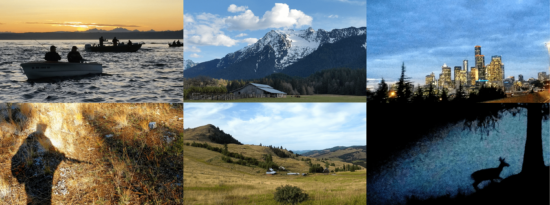
WDFW Looking For Public Input On New 25-year Strategic Plan
Late last year I got an unexpected email that top WDFW honchos wanted to talk about their new 25-year strategic plan.
The agency was in the early stages of developing an outline for how “to protect and preserve our unique fish, wildlife, and habitat” in the face of a growing human population and increasing threats to the natural world as we know it, and they wanted my input.

I was humbled, but mostly amused. Honestly, I have trouble thinking more than 25 minutes ahead of Right Now and … squirrel!!!
Despite warning the agency that I ain’t quite the deep thinker they might think I am, I ended up chatting with Director Kelly Susewind, Conservation Director Jeff Davis and Project Coordinator Rob Geddis for nearly an hour in early January.
By chance I’d just hit post on a 5,500-word blog about the top fish and wildlife stories of the 2010s, laying out the challenges our favorite critters, activities and lands faced and will continue to do so, so my advice to the trio was informed by that and other things I’ve written and mulled and remulled over the years.
Now it’s your turn to give WDFW input on what their strategic direction should be for the next two and a half decades, and if there’s a group that has something to say about fish, wildlife, their management and habitat in the Evergreen State, it’s sportsmen.
The timing couldn’t be more crucial either — we’re at an “inflection point for Washington’s natural heritage,” in the words of another close observer.
WDFW today released a draft plan and is looking for public feedback.
“Understanding how we can meet public expectations is a big part of whether we’re going to be successful stewards of fish, wildlife and the public’s trust. If we’re on the right or wrong track, we want to know,” said Susewind in a press release.
Talking with folks like me, fishing, hunting and conservation organizations, members of the Budget and Policy Group, agency staffers and others, they heard a pretty consistent message about what they must keep doing and what they need to get better at.
“Conversations repeatedly circled back to the need to see significant strides in conservation if we’re going to avoid continued fish and wildlife population declines – through community engagement and science, in particular,” said Davis in the press release.
He said the strategic plan will also “provide clarity” about WDFW’s mission so that it and groups can be on the same page in terms of helping Washington fish and wildlife.
From the 35,000-foot level, the plan hits on “five key areas of change”:
- Proactively address conservation challenges,
- Build passionate constituencies through community engagement,
- Connect people to nature and conservation through recreation and stewardship,
- Deliver science that informs Washington’s most pressing fish and wildlife questions, and
- Move WDFW toward operational and environmental excellence.
There are three ways to provide your input:
At the Fish and Wildlife Commission’s Friday, June 12, digital meeting, starting at 1:50 p.m., and again at the panel’s July 17 get-together.
And by using this feedback form with 10 questions through July 10.
The commission is scheduled to consider adopting the plan at its Aug. 21 meeting.
